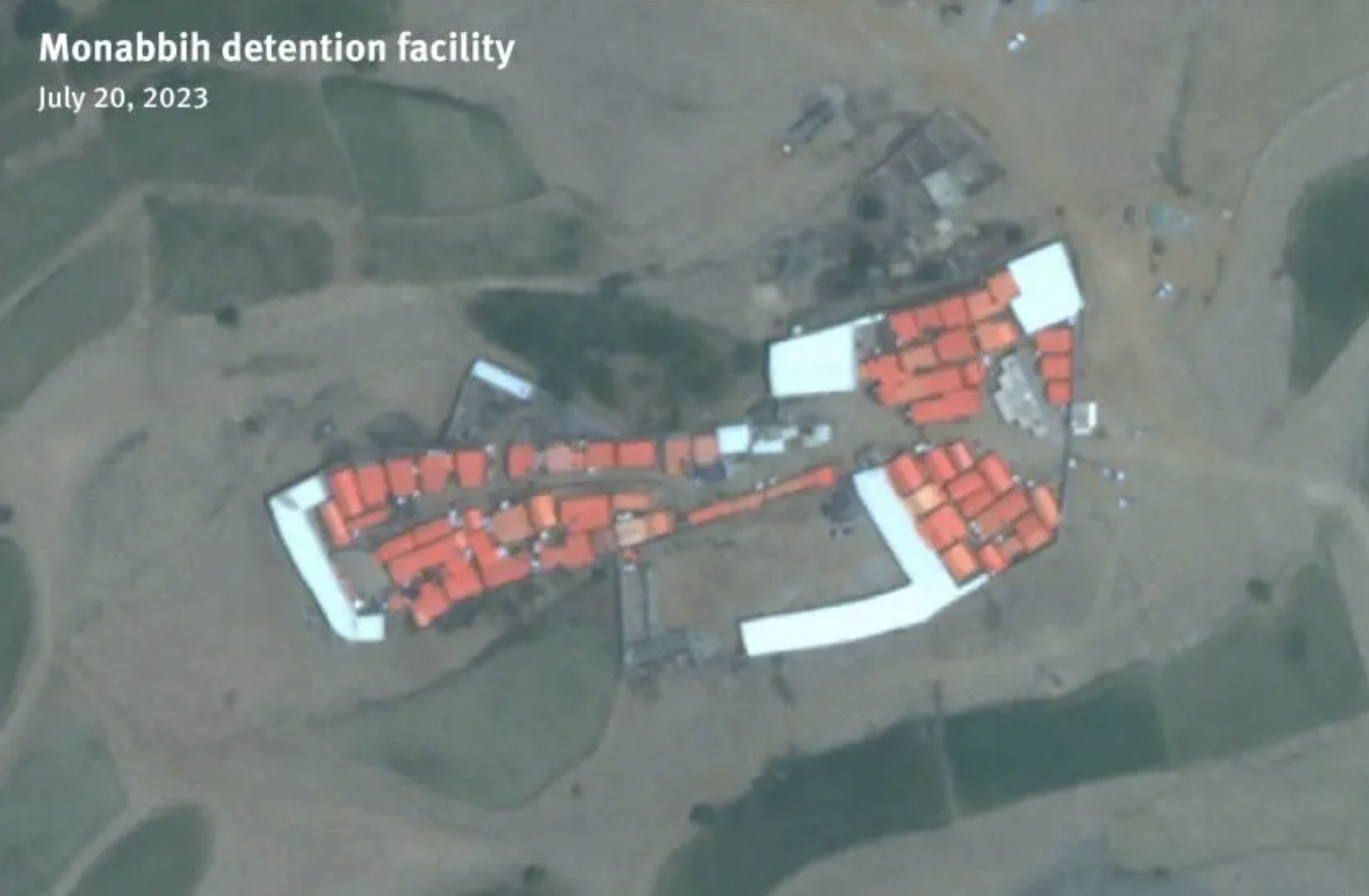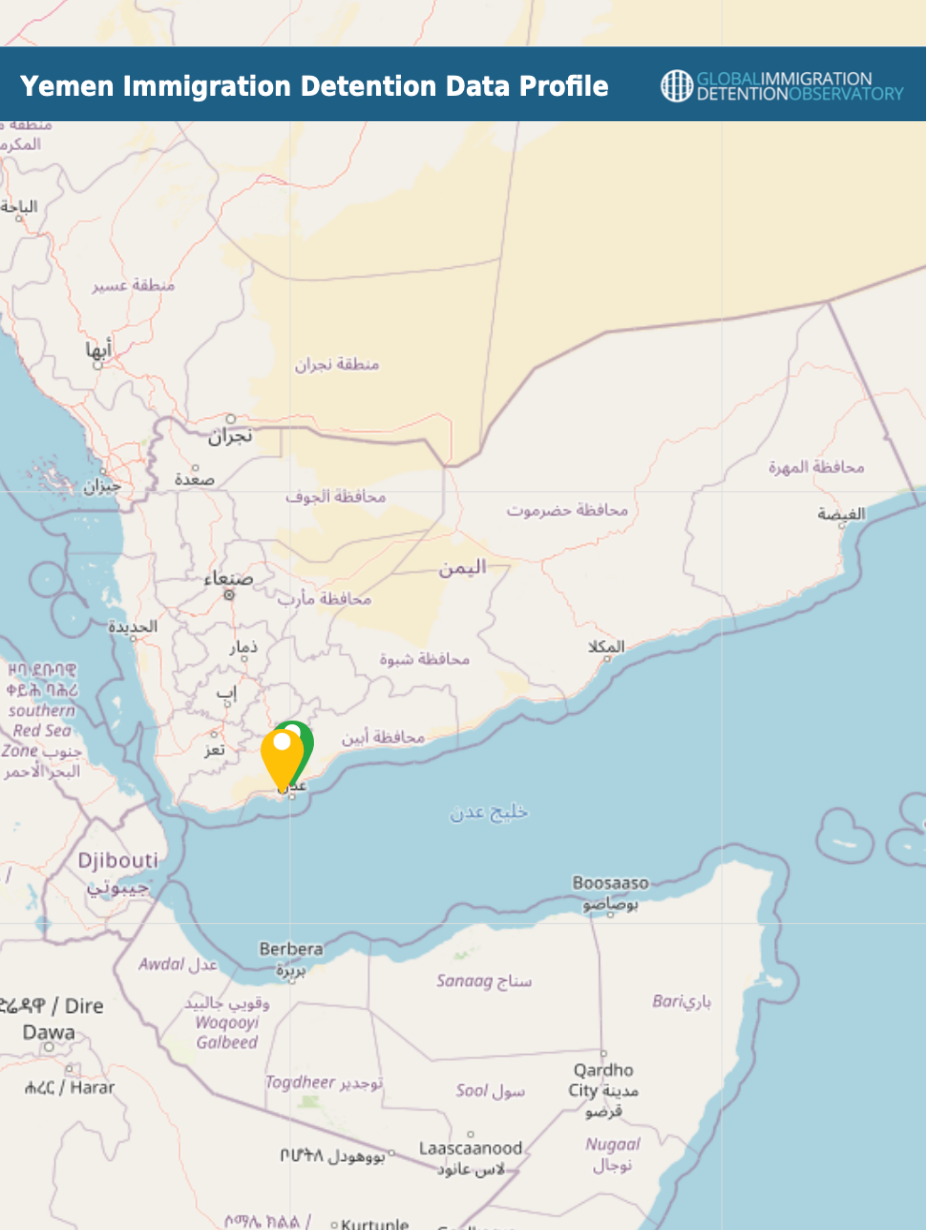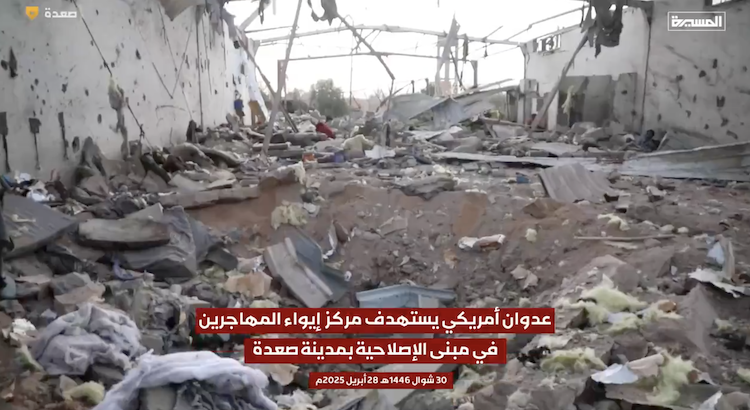In the early hours of Monday 28 April, a US airstrike is reported to have struck a detention facility in Yemen’s northern Sa’ada Governorate, killing dozens of migrants confined in the building. This is not the first time that a detention centre holding migrants has been struck in Yemen: another facility within the same compound was struck in 2022 leaving more than 90 dead. […]
Migrants and Asylum Seekers Face Violent Attacks, Then Detention, At Saudi Border.
In a new report, Human Rights Watch (HRW) details the horrific killing of hundreds of migrants and asylum seekers at the Saudi-Yemen border. According to the report, Saudi border guards have used explosive weapons and shot at groups of people–largely Ethiopian migrants and asylum seekers–killing hundreds, amongst them women and children. Those who survive have […]

Yemen: Covid-19 and Detention
On 21 January, a Saudi Arabia-led coalition airstrike in Yemen struck a detention centre in the Sa’ad province under the control of rebel Houthi forces, killing at least 82 people and injuring 266 others. Médecins Sans Frontières reported that the al-Gumhourriyeh hospital in Sa’da had taken in around 200 wounded but that there were “many […]

Yemen: Covid-19 and Detention
Amidst an ongoing conflict that has led to hundreds of thousands of deaths and widespread famine, migrants and refugees in Yemen–most of whom are from Ethiopia or Somalia–continue to face detention and physical threats in the country, in part because of rumors that they are spreading COVID-19 (see the 4 August 202 update on this […]

Yemen: Covid-19 and Detention
Although it has been devastated by ongoing civil war and famine, Yemen has continued to serve as an important migrant and refugee transit country–with many people often enduring torture, rape, and extortion, as well crossfire and airstrikes. In 2019, the IOM estimated that some 138,000 migrants departed from the Horn of Africa to Yemen in […]

Last updated: May 2019
Migrants in Yemen Languish in Detention as Ramadan Begins
From: International Organization for Migration
Date: 7 May 2019
Aden - Some 3,000 migrants continue to be held in two temporary detention sites in Yemen's Aden and Abyan governorates. Among those detained are Ethiopian nationals, many practicing Muslims, who are embarking on thirty days of Ramadan fasting while detained.
The International Organization for Migration (IOM) has been providing clean water and emergency food at the 22nd of May Stadium in Aden where nearly 2,500 migrants are detained.
On 21 April, authorities in Yemen began detaining nearly 5,000 irregular migrants in two sports stadiums and a military camp in the Aden, Abyan and Lahj governorates. The detainees predominately are Ethiopians, who entered Yemen to seek livelihoods and opportunities on the Arabian Peninsula.
On Friday (03/05), IOM’s Displacement Tracking Matrix (DTM) teams confirmed that 2,473 migrants remain under detention in Aden’s 22nd May Stadium. Of those, the DTM determined 873 are children.
Since last week’s headcount, more people have been brought to that site. An estimated 500 migrants are also being held in a second sports stadium in Abyan.
At the stadium in Aden, IOM is combatting the spread of communicable disease by providing water, sanitation and hygiene (WASH) and health services. Between 26 April and 5 May, IOM has conducted over 1,800 health consultations and rehabilitated 30 latrines.
In recent days, more than 1,400 people detained at the military camp in Lahj reportedly were released. IOM is making efforts to confirm the locations and wellbeing of all migrants released in Lahj, particularly because some had been suffering from acute watery diarrhea (AWD).
At Lahj’s Ibn Khaldoon Hospital, IOM is treating more than 70 former detainees with AWD in its newly-opened diarrhea treatment centre. Tragically, since Wednesday (01/05), 14 migrants have perished from the illness
Twenty-three-year-old Abdi* comes from a farming family in the Oromia region of Ethiopia. As Ramadan commences, he wishes he could go home, or anywhere rather than stay in detention in the sports stadium in Aden. “I wanted to come to an Arabian country to make my life better than my parents’, but when I arrived here [in Yemen] they caught me and brought me to this place,” said Abdi, who left his home just over a month ago without telling his parents. Starting his journey with only 2,000 birr [USD 70], he eventually he arrived in Djibouti, where he called his parents explaining he needed funds, some 11,000 birr [USD 380], to continue his journey. His parents sold a cow. He said he knew he would perish in the desert without a smuggler to help him complete this “hard journey.” *Name changed to protect identity |
IOM remains extremely concerned for the people being held in inhumane conditions in Aden and Abyan. Alongside humanitarian partners, IOM is providing lifesaving services, while engaging with authorities to advocate for the release of those detained.
Thousands of migrants are stranded in other locations throughout Yemen. From Sana'a starting this past Monday, IOM intends to move a total of 327 Ethiopian migrants to Addis Ababa, under IOM’s voluntary humanitarian return (VHR).
For more information, please contact Olivia Headon at IOM Yemen, Tel: +353833022648, +967730552233, +967730552233, Email: oheadon@iom.int
-----
Migrants Die While Detained in Inhumane Conditions in Yemen
IOM is monitoring the conditions of some 5,000 migrants from the Horn of Africa held across three sites –-two sports stadiums and a military camp–in Yemen’s Aden, Lahj and Abyan governorates.
IOM learned yesterday (01/05) that at least eight migrants died from complications related to acute watery diarrhea (AWD) at the Ibn Khaldoon Hospital in Lahj governorate. Those migrants—predominantly Ethiopian—had been held at a military camp in Lahj where more than 1,400 people are detained. Authorities at the camp report they have detected at least 200 AWD cases. IOM is establishing a diarrhea treatment centre at Ibn Khaldoon Hospital, which is currently struggling to treat 53 AWD cases, including eight severe cases.
This morning, 14 migrants with signs of AWD were brought to Aden’s 22nd of May stadium where IOM is providing critical life saving assistance. IOM’s health team, who has carried out over 1,000 health consultations at the site since 26 April, acted fast to ensure the patients were evacuated to a nearby hospital.
In Geneva, Mohammed Abdiker, IOM’s Director of Operations and Emergencies said, “I am deeply saddened by the deaths of these eight migrants, who were among the thousands of migrants being held in deplorable conditions across Yemen. We have decried this policy to the authorities, urging them to take a humane approach to irregular migration.”
IOM’s team in Aden became aware of the mass arrest and detention of thousands of migrants on 21 April and their detention in cramped buildings, not fit for human inhabitation. Abdiker noted these migrants, “at best, have only limited access to basic services or protection.”
On Tuesday (30/04), guards fired on migrants detained at the Aden sports stadium, two of whom suffered gunshot wounds, leaving a teenage boy likely paralyzed for life. That, Abdiker said, “demonstrates the inability of authorities to care for the expanding detained population as well as the immediate need to have a dedicated civilian authority humanely managing these sites. Our teams could see that without ensuring immediate access to sufficient food, clean water, safe sanitation and medical attention, a catastrophe was waiting to unfold.”
Abdiker added: “IOM stands ready to support Yemen and other regional partners to identify sustainable responses to irregular migration, which do not involve the shortsighted abuse of vulnerable migrants and fully respects international law.”
“I am greatly concerned that this dire situation will further deteriorate,” he concluded. “Our team on the ground has been making strides with local advocacy among the different levels of government. However, it is time to see these words turned into action that puts an end to this abuse before more innocent lives are lost.”
For more information please contact Olivia Headon in Aden. Tel: +967 730 552 233. Email: Oheadon@iom.int
DETENTION STATISTICS
DETAINEE DATA
DETENTION CAPACITY
ALTERNATIVES TO DETENTION
ADDITIONAL ENFORCEMENT DATA
PRISON DATA
POPULATION DATA
SOCIO-ECONOMIC DATA & POLLS
LEGAL & REGULATORY FRAMEWORK
Does the Country Have Specific Laws that Provide for Migration-Related Detention?
Detention-Related Legislation
GROUNDS FOR DETENTION
Immigration-Status-Related Grounds
Non-Immigration-Status-Related Grounds in Immigration Legislation
Criminal Penalties for Immigration-Related Violations
Grounds for Criminal Immigration-Related Incarceration / Maximum Length of Incarceration
Has the Country Decriminalised Immigration-Related Violations?
LENGTH OF DETENTION
PROCEDURAL STANDARDS & SAFEGUARDS
Access to Detainees
COVID-19 DATA
TRANSPARENCY
Transparency Score on Migration-Related Detention
MONITORING
NATIONAL HUMAN RIGHTS MONITORING BODIES
NATIONAL PREVENTIVE MECHANISMS (OPTIONAL PROTOCOL TO UN CONVENTION AGAINST TORTURE)
NON-GOVERNMENTAL ORGANISATIONS (NGOS)
GOVERNMENTAL MONITORING BODIES
INTERNATIONAL DETENTION MONITORING
INTERNATIONAL TREATIES & TREATY BODIES
International Treaties Ratified
Ratio of relevant international treaties ratified
Relevant Recommendations or Observations Issued by Treaty Bodies
> UN Special Procedures
> UN Universal Periodic Review
Relevant Recommendations or Observations from the UN Universal Periodic Review
HEALTH CARE PROVISION
HEALTH IMPACTS
COVID-19
Country Updates
Government Agencies
Republic of Yemen Government Portal: https://www.mofa-ye.org/Pages/en/
International Organisations
UNHCR Yemen Country Profile: https://www.unhcr.org/where-we-work/countries/yemen
IOM Yemen Country Profile: https://www.iom.int/countries/yemen
NGO & Research Institutions
Human Rights Watch: https://www.hrw.org/middle-east/n-africa/yemen
Amnesty International: https://www.amnesty.org/en/countries/middle-east-and-north-africa/yemen/




